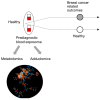Mapping the Human Exposome to Uncover the Causes of Breast Cancer
- PMID: 31892107
- PMCID: PMC6982073
- DOI: 10.3390/ijerph17010189
Mapping the Human Exposome to Uncover the Causes of Breast Cancer
Abstract
Breast cancer is an important cause of morbidity and mortality for women, yet a significant proportion of variation in individual risk is unexplained. It is reasonable to infer that unexplained breast cancer risks are caused by a myriad of exposures and their interactions with genetic factors. Most epidemiological studies investigating environmental contribution to breast cancer risk have focused on a limited set of exposures and outcomes based on a priori knowledge. We hypothesize that by measuring a rich set of molecular information with omics (e.g., metabolomics and adductomics) and comparing these profiles using a case-control design we can pinpoint novel environmental risk factors. Specifically, exposome-wide association study approaches can be used to compare molecular profiles between controls and either breast cancer cases or participants with phenotypic measures associated with breast cancer (e.g., high breast density, chronic inflammation). Current challenges in annotating compound peaks from biological samples can be addressed by creating libraries of environmental chemicals that are breast cancer relevant using publicly available high throughput exposure and toxicity data, and by mass spectra fragmentation. This line of discovery and innovation will extend understanding of how environmental exposures interact with genetics to affect health, and provide evidence to support new breast cancer prevention strategies.
Keywords: adductomics; breast cancer; exposome; metabolomics.
Conflict of interest statement
R.A.R. and V.B. are employed at the Silent Spring Institute, a scientific research organization dedicated to studying environmental factors in women’s health. The Institute is a 501(c) 3 public charity funded by federal grants and contracts, foundation grants, and private donations, including from breast cancer organizations. The authors declare they have no actual or potential competing financial interests.
Figures

References
-
- Ward E.M., Sherman R.L., Henley S.J., Jemal A., Siegel D.A., Feuer E.J., Firth A.U., Kohler B.A., Scott S., Ma J., et al. Annual Report to the Nation on the Status of Cancer, Featuring Cancer in Men and Women Age 20–49 Years. J. Natl. Cancer Inst. 2019;111:1279–1297. doi: 10.1093/jnci/djz106. - DOI - PMC - PubMed
-
- Lichtenstein P., Holm N.V., Verkasalo P.K., Iliadou A., Kaprio J., Koskenvuo M., Pukkala E., Skytthe A., Hemminki K. Environmental and heritable factors in the causation of cancer--analyses of cohorts of twins from Sweden, Denmark, and Finland. N. Engl. J. Med. 2000;343:78–85. doi: 10.1056/NEJM200007133430201. - DOI - PubMed
-
- Breast Cancer and the Environment: A Life Course Approach: Health and Medicine Division. [(accessed on 19 December 2019)]; Available online: http://www.nationalacademies.org/hmd/Reports/2011/Breast-Cancer-and-the-....

